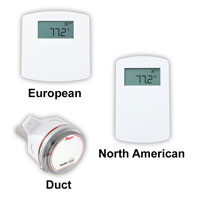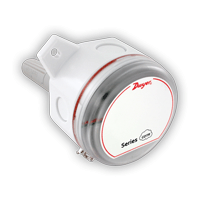Carbon Dioxide, Relative Humidity and Temperature – All in One Transmitter
Carbon Dioxide, Relative Humidity and Temperature – All in One Transmitter

Along with relative humidity, the carbon dioxide level tells building automation controllers when to permit the flow of additional outside air for blending with the recycled air. Monitoring carbon dioxide allows the controller to tell when a building is occupied versus unoccupied. When construction of a new building is underway, installing a carbon dioxide sensor and a separate relative humidity/temperature sensor can be easily done. However, measuring carbon dioxide levels is a relatively new addition to energy management so many buildings were constructed before carbon dioxide monitoring was established, thus only relative humidity and temperature measurements were specified and installed.
Requests for the addition of carbon dioxide monitoring in existing buildings can involve making new routes for conduit in existing walls causing the labor to be a potentially large cost. It is in this situation that the Series CDTR has its largest advantage. The CDTR can be installed where an existing humidity/temperature sensor is, using the existing conduit.
In researching the concerns of integrators and contractors alike, considerations were made in creating the series CDTR. The first consideration is the use of jumpers for units to be fully selectable for the output of the carbon dioxide, relative humidity, and temperature measurements. The carbon dioxide and relative humidity measurements can have the analog output selected as 4-20 mA, 0-5 VDC, or 0-10 VDC. The temperature measurement can similarly be ordered as an analog output, or as a thermistor or RTD output that would best match the controller input.
The second consideration Dwyer has put into the CDTR Series is the ability to replace the humidity sensor and thermistor. On other models, if the humidity sensor were to fail or need to be replaced the whole transmitter would need to be replaced. With the DwyerCDTR, the humidity sensor and the thermistor can be replaced with a spare part, allowing for minimal labor and equipment cost on replacements and repairs.

The third consideration is the carbon dioxide technology used in the transmitter. The CDTR uses the same sensor as our popular CDT series. Both use a single-beam dual-wavelength non-dispersive infrared (NDIR) sensor. This sensor technology provides the highest level of accuracy compared to the popular Automatic Baseline Correction (ABC) method. The ABC method uses a point in time to automatically assume the building is unoccupied and then makes the baseline adjustment. If the building is occupied at the time of adjustment, or the carbon dioxide level is higher than it assumes, the measurements will begin to skew. The sensor in the CDTR is a single beam of light, but has two wavelengths of the light being measured. This allows one wavelength to measure the carbon dioxide level, while the other measures the degradation of the light. Measuring the degradation of the light allows for the sensor to automatically correct the carbon dioxide reading to allow for longer life of the instrument. Should recalibration be necessary the sensor can be field calibrated.
The final consideration is the optional display. The display can be selected to show: carbon dioxide and relative humidity, carbon dioxide and temperature, relative humidity and temperature, carbon dioxide only, relative humidity only, or temperature only. Many applications that require displaying temperature do not need to display relative humidity or carbon dioxide while all three are measured.
Overall the new CDTR Series was developed to meet the multiple needs specified through rigorous research and informative meetings with building engineers and integrators alike. With the constant feedback received by the users, Dwyer looks to continue manufacturing quality instruments at affordable rates, and provide the support that is required in integrating the CDTR.
